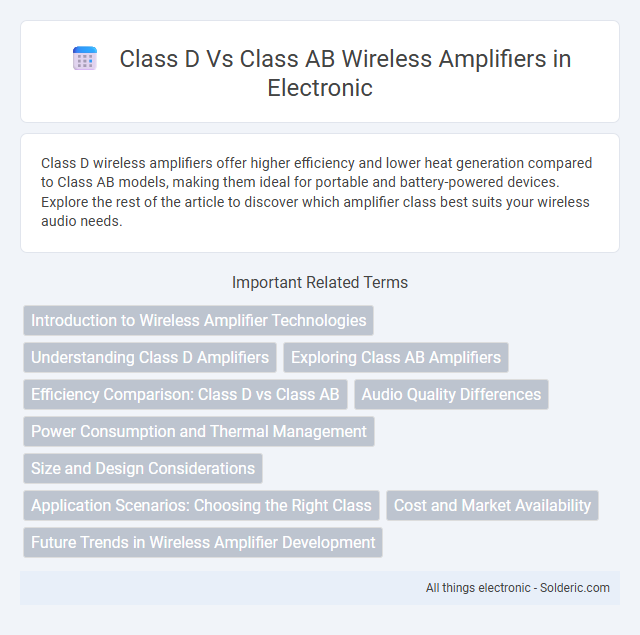Class D wireless amplifiers offer higher efficiency and lower heat generation compared to Class AB models, making them ideal for portable and battery-powered devices. Explore the rest of the article to discover which amplifier class best suits your wireless audio needs.
Comparison Table
| Feature | Class D Amplifier | Class AB Amplifier |
|---|---|---|
| Efficiency | High (up to 90%+) | Moderate (50-70%) |
| Heat Generation | Low | High |
| Sound Quality | Good, may have switching noise | Excellent, low distortion |
| Size & Weight | Compact and lightweight | Generally larger and heavier |
| Cost | Typically lower for wireless applications | Higher due to complex design |
| Applications | Wireless systems, battery-powered devices | High-fidelity audio, premium wireless amplifiers |
| Complexity | Moderate, requires filtering | Lower complexity |
Introduction to Wireless Amplifier Technologies
Class D wireless amplifiers operate with high efficiency by switching transistors fully on or off, minimizing power loss and heat generation, making them ideal for portable and battery-powered devices. Class AB amplifiers combine the linearity of Class A and efficiency of Class B, providing better audio fidelity with moderate efficiency suitable for applications requiring high sound quality. Understanding the differences in operation and performance helps optimize amplifier selection for wireless audio systems balancing power consumption and sound clarity.
Understanding Class D Amplifiers
Class D wireless amplifiers use pulse-width modulation (PWM) to switch output transistors fully on or off, significantly increasing efficiency by minimizing power loss compared to linear amplification in Class AB designs. These amplifiers typically achieve efficiency rates above 90%, resulting in reduced heat dissipation and smaller heat sink requirements, which is crucial for portable and battery-powered wireless audio devices. Despite potential concerns over signal distortion, advances in digital signal processing have enhanced the audio fidelity of Class D amplifiers, making them well-suited for modern high-performance wireless applications.
Exploring Class AB Amplifiers
Class AB amplifiers combine the advantages of Class A and Class B topologies, offering a balance between linearity and efficiency ideal for high-fidelity audio applications. They operate with both transistors conducting slightly at all times, reducing crossover distortion commonly found in Class B amplifiers while delivering better sound quality than Class D models. You can expect Class AB amplifiers to provide warm, detailed audio performance, making them suitable for audiophiles who prioritize sound clarity over the highest power efficiency.
Efficiency Comparison: Class D vs Class AB
Class D wireless amplifiers achieve efficiencies typically between 80% to 95% by using pulse-width modulation and switching output transistors fully on or off, drastically reducing power loss and heat generation. In contrast, Class AB amplifiers operate with linear output stages, resulting in lower efficiencies around 50% to 70%, as they conduct current over a larger portion of the signal cycle and dissipate more heat. The higher efficiency of Class D amplifiers makes them ideal for battery-powered wireless applications where power conservation and thermal management are critical.
Audio Quality Differences
Class AB wireless amplifiers offer superior audio quality due to their analog design, delivering low distortion and a warm, natural sound preferred in high-fidelity applications. Class D amplifiers, while highly efficient and compact, can introduce higher levels of electromagnetic interference and switching noise, which may affect audio fidelity but are often mitigated with advanced filtering techniques. The choice between Class D and Class AB amplifiers depends on balancing audio quality requirements against power efficiency and device size constraints.
Power Consumption and Thermal Management
Class D wireless amplifiers consume significantly less power due to their high efficiency, often exceeding 90%, which reduces energy waste and extends battery life in portable devices. Class AB amplifiers, operating with lower efficiency around 50-70%, generate more heat, necessitating robust thermal management systems such as heat sinks and cooling fans. Enhanced thermal performance in Class D amplifiers minimizes the risk of overheating and allows for more compact, lightweight designs suitable for modern wireless applications.
Size and Design Considerations
Class D wireless amplifiers feature compact, lightweight designs, making them ideal for portable and space-constrained applications, while Class AB amplifiers are generally larger due to their more complex circuitry and heat dissipation requirements. The efficiency of Class D amplifiers reduces the need for bulky heat sinks, enabling sleeker form factors in modern wireless audio devices. In contrast, Class AB amplifiers often necessitate robust thermal management solutions, influencing their overall size and limiting design flexibility.
Application Scenarios: Choosing the Right Class
Class D amplifiers excel in battery-powered and portable wireless devices due to their high efficiency and low heat dissipation, making them ideal for smartphones, Bluetooth speakers, and hearing aids. Class AB amplifiers are preferred in high-fidelity audio systems and professional sound reinforcement where audio quality and linearity outweigh power efficiency concerns. Selecting the right class hinges on balancing the demands for power efficiency, audio fidelity, and thermal management specific to the wireless application's operational environment.
Cost and Market Availability
Class D wireless amplifiers offer lower production costs due to their higher efficiency and simpler heat dissipation requirements, making them widely available and popular in budget-friendly audio solutions. Class AB amplifiers, with their more complex circuitry and higher power consumption, tend to be more expensive and are less common in mass-market wireless devices. The cost difference drives Class D amplifiers to dominate in consumer electronics, while Class AB units are often reserved for niche markets valuing audio fidelity.
Future Trends in Wireless Amplifier Development
Class D wireless amplifiers are increasingly favored for their high efficiency and compact size, enabling longer battery life and reduced heat dissipation in portable devices. Future trends emphasize integrating advanced digital signal processing and AI algorithms to optimize sound quality and power management dynamically. Your next wireless amplifier may leverage these innovations to deliver superior audio performance while maintaining energy efficiency and minimal latency.
Class D vs Class AB wireless amplifiers Infographic

 solderic.com
solderic.com